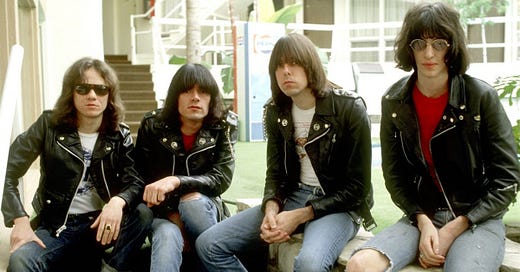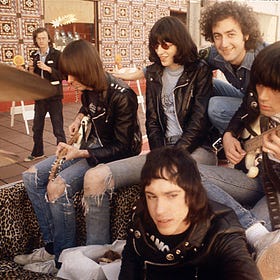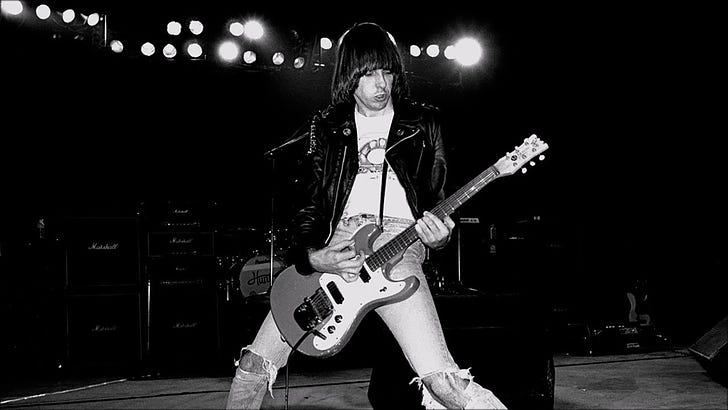Keyless Entry: My Night in The Ramones' Houston Hotel Room, 1978
Short of the occasional groupie, I'm guessing very few, if any, people were granted such close access to the influential and eventual Rock'n'Roll Hall of Famers!
I first met The Ramones almost a year to the day after they dropped an earth-shattering musical bomb on London, leaving their new, clear fall-out raining over hundreds of local dead-end dole kids bored with 40-year-old duffers filling songs with extended guitar twiddling and half-hour drum solos (think Eagles and Fleetwood Mac).
The very next day, many of them grabbed guitars, formed bands, perfected their 1 to 4 count, and became the second “British Invasion” to accost the world in just over a decade.
On this page, I’ll first cover the July ‘77 and February ‘78 Houston stops on the boys’ stateside blitzkrieg, of which I was happy to be but a tiny part. A little later (a few paragraphs down), I’ll let some of the principles intimately involved in the original ‘76 London siege take over.
The Game of the Name
Paul McCartney would sign into hotel rooms as “Paul Ramone.”
Well-documented Ramones lore long ago disclosed how four unrelated lads from Forest Hills, Queens arrived at their seemingly familial surname. The Beatles’ Paul McCartney, to effectively dodge the herds of “birds” descending relentlessly on their chosen hotels during the 1960s Beatlemania heyday, would sign into hotel rooms as “Paul Ramone.”
Which reminds me of early published accounts by either Joey or Johnny that, during their initial mid-’70s attempts at live, New York area shows, low attendance at traditional punk venues was blamed on how audiences might’ve thought “The Ramones” was a Mexican cha-cha band!
Whether or not Johnny, Joey, Dee Dee, Tommy or Marky ever signed hotel registers as, say, “Joey Beatle” to elude fans, won’t be solved here. But, if you ever wondered what might have gone on behind the scenes in Room 542 in a downtown Houston hotel with whom I’ve sometimes called the “Beatles of punk,” wonder no more.
(If you’re wondering about that possibly bold assertion, my equation: If the Ramones were the Beatles of punk, The Clash were the Stones, The Buzzcocks were The Kinks, and The Jam were The Who. A debate for another time, perhaps, but nevertheless, a simple tonal analogy from just a scant decade after those seminal ‘60s British legends made their respective influential marks in the first “British Invasion”)!
Don’t Miss the Bell:
Close Encounter of the Fifth Kind

A fan since their self-titled debut LP was released by Sire/ABC Records in April 1976, I made it a point to see their shows every time they toured through Houston. Their first time was in July 1977 (see photo above, taken by good friend and pro photog, the late Larry Lent), and as their only backstage guest, I got some great “alone time” with the lads. In 1977 Houston, they were lucky to draw a dozen or two fans for a show, such a punk-hating/country-western loving town that it was.
As a 22-year-old peddling vinyl during the day at Houston’s only record store that mattered, Cactus Records (and with a couple years in FM rock radio behind me, nurturing local label rep friendships), I was privy to scads of promo materials from most labels, including the (usually) white label promo albums. This was true of The Ramones, especially after Sire Records stepped away from ABC distribution in 1977 to a deal with Warner Bros. Records.
Early Label Affiliations
In fact, in 1978, Warners actually acquired the Seymour Stein-led Sire as an official affiliated label. This meant that The Ramones’ first two albums (debut as well as January 1977’s Leave Home), including attendant singles, were both released twice, once with a yellow Sire label, with distribution attributed to ABC, and again (at time of signing Warner distribution, then its subsidiary label status), with the same yellow Sire label, but with new Warner info on label and jacket. The true Ramones completist has both labels’ issues!
Needless to say, any ABC-affiliated Ramones product was and is rare and desirable. I had amassed a large volume of autographed 45 picture sleeves, posters, and “dummy” album covers (or “flats” as retail called them) used for displays, and even had the original Warners-issued promo white-on-black Ramones logo t-shirt.
Each time The Ramones played Houston, I’d bring a new pile of Ramones paraphernalia for them to sign, and I’m happy to report that they were all generous with their time and happy to figuratively “beat on the Brad with a ballpoint pen,” signing everything I put in front of them.
I’m less happy to report that my collection of signed items is all scattered across the globe (this one), having been sold off on eBay around the turn of the century (this one).
In fact, the late Arturo Vega himself (Ramones artistic director, and creator of the iconic, round, Eagle-with-baseball-bat “Look Out Below” logo) actually bought a rare promo piece from me at the time (nope, can’t recall what it was)! I included a note to him, though, in the package, reminding him how cool it was to have met him about 22 years previous (he didn’t reply).
I Was “Rob-bed,” But I Ended Up With the Goods!
It was sometime around the time of Warners acquiring Sire (1978) that I met Rob Sides, the 20-something Houston-area Warner Bros. Records regional rep. He, of course, had his well-manicured hands full servicing radio and retail with promos and related posters, t-shirts, and buttons for the likes of Warner superstars like Fleetwood Mac, James Taylor, America, Rod Stewart, and the Doobie Brothers.
He, like the rest of their reps, nationwide, had little to no time (or interest, for that matter) in pushing to radio or retail what they were pre-convinced would be a waste of time to even distribute. Their corporate interests in keeping the mega-selling artists at the top of their ledger sheet far outweighed their desire to do the legwork necessary to break an unknown act, even (or especially) one that lives in the “fringe,” angry and unproven new sub-genre like punk.
Notice how the corporate “rock acts” named above are, now, in a new, young century, considered either easy listening or certainly A/C (adult contemporary), and most have (or have had) their own XM/Sirius satellite radio-dedicated channel, while also single-handedly virtually inventing “yacht rock”!
I was paid quite handsomely in what we now call “swag”!
All of this is to say that, when I visited Rob in his regional Warners office, his promo “punk stuff” was laying decidedly dormant, gathering dust and the occasional spider web in the corner, having not been touched since arriving in the mail from the home of The Bunny, beautiful downtown Burbank.
So, he let me take, quite liberally, armloads of Ramones (and Talking Heads, Tuff Darts, Dead Boys, Richard Hell, Renaissance, and other Sire acts of the day) promo items about once a week! He, of course, was aware I worked at Cactus, and I assured him I was utilizing the posters and flyers in displays I’d build at the store, as well as distributing the freebie singles and albums to fellow workers at the store.
In that way, I was sort of a volunteer merchandising apprentice for Warner Bros., and was more than happy to be the one to make sure these acts got some in-store play with visual aids (at my store, anyway), and I talked them up with customers at every opportunity.
I remember quizzing Rob about possibly delivering these promo items to other stores in the area, but he advised against it as I was not an “official” Warners employee. But, to my mind, I was paid quite handsomely in what we now call “swag”!
Back to Liberty Hall, 1977
At 22, I went backstage not as an interviewer, but simply a fan with local radio and record biz credentials (plus, the guys were beyond eager to have some company). I did manage to get Johnny to reveal his current tour read, surprisingly a Jack Benny biography, and his secret for his trademark rapid downstroke-only guitar technique: “Practice,” he replied cryptically.
Little did I know at the time, but Johnny has always been a huge baseball fan, even counting pro players and GMs as friends. I fully covered that little-known Johnny angle here:
It wasn’t until the next year, on their February 1978 swing through Houston, that I was asked back to their hotel room after the show by the late Linda Stein, wife of Sire Records president Seymour Stein at the time. She traveled with the band on many occasions (as co-manager with Danny Fields). This was either a suite, or one of a couple or three rooms they had to have for the boys and crew (among whom was Vega and road manager Monte Melnick).
Tale of the Tape
In a piece of remarkable behind-the-scenes trivia unknown by most fans, Linda always had a new audio cassette tape shipped ahead of the band. It was waiting for them at each new city’s hotel. It’s likely she had an arrangement with Paul McNally, the head of Sire’s UK office, to record a mix tape of sorts, and forward the songs to her.
I sat on the floor next to Dee Dee where we leaned, cross-legged, against the dresser while Linda played the tape. Joey stood against the opposite wall listening quietly, while Johnny was taking in the tape’s content with especially studied intent.
I wish I would’ve taken notes on the bands and songs we heard from that cassette player that night, but bands like Sham 69, the Buzzcocks, or 999 (or other British acts of the day) wouldn’t have been out of the question.
I can’t recall where the seemingly elusive Tommy was, here or even backstage in ‘77 for the above photo. For this hotel room visit, Tommy was about three months away from his decision to leave in May ‘78, thereby making way for Marky—the former Marc Bell—to take over on drums after stints with New York-based rockers Dust and Estus, Wayne County’s band, and Richard Hell and the Voidoids.
The cassette was filled with the latest punk rock coming out of England, a rapidly exploding scene The Ramones helped spawn after two landscape-altering shows in July 1976 at The Roundhouse and Dingwalls in London.
According to squaremile.com from May 2018: “There were two gigs in London that weekend – on 4 July [The Ramones] played the Roundhouse, and the next night Dingwalls, in a much smaller room.
“In the audience both nights were members of new bands – some of which had never, or hardly ever, performed in public – including the Sex Pistols, The Clash, The Damned, The Pretenders, and likely more.”









The Ramones were the loudest band I have ever seen
This is the coolest story Brad!